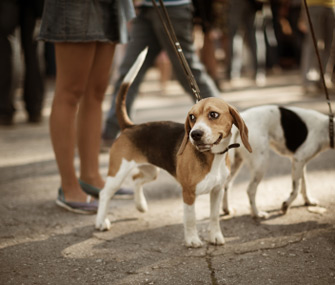Can I Teach My Dog to Pee on Concrete?
Published on January 03, 2013

Q. My dog doesn't want to pee on concrete. How do I train him to do this?
A. A dog who has only been taught to potty in a specific place or on a specific substrate can have problems when he is asked to potty somewhere different. This often happens with dogs transitioning from using a potty pad indoors to going outside on grass or concrete. It can also happen when a dog is moved from one home to another, such as leaving a house with a lawn for an apartment building surrounded by sidewalks.
Teaching your dog proper potty habits starts in puppyhood. During this time I encourage pet parents to take their puppy for potty breaks on a variety of outside surfaces, including grass, concrete, sand and gravel. This helps your dog learn to be less selective later about which outside surfaces he will potty on. It is important to deal with potty training issues early; it can be agonizing for your dog to hold his bladder for long periods of time, and it’s inconvenient for you when faster bathroom breaks are needed.
My first recommendation with any potty training issue is always to start with a veterinary checkup. Once your dog has been cleared by your veterinarian, it’s time to start training.
Take Your Time
Start by figuring out if your dog prefers a particular substrate or a particular location for his potty breaks. One Husky mix I trained was so accustomed to going on the potty pad in the kitchen that he would never go to the bathroom outside. If the potty pad was moved, he would still potty in the kitchen. For him, the location, not the surface, was the most important indicator of where he was supposed to go. For this dog, I moved the potty pad an inch every day, slowly edging it farther away from the kitchen and closer to the yard. This took several weeks.
Once the potty pad was moved outside and onto the grass, the next step was to cut it into smaller and smaller pieces until the potty pad was gone altogether and only the grass remained. The dog was successfully trained to potty outside, but only because he made a very gradual transition from kitchen to yard.
Look for ways to make your dog’s transition from his current preferred surface to concrete as gradual and easy as possible. If your dog prefers to potty in the grass, see if there are ways to slowly introduce concrete. Get creative: Rather than taking him to a large grassy space to potty, look for areas with only limited amounts of grass poking up through the sidewalk or on the side of the street.
Another option is to invest in a portable grass area for your pet. Over time, you can transition the grass directly onto the concrete from any base it may be on (certain models of grass are easily removable from the stand). Once your dog is readily going on the grass set on concrete, slowly decrease the size of the grass by cutting it into smaller and smaller pieces until your dog is going solely on the concrete.
Add a Verbal Cue
To further help your dog go to the bathroom when and where you ask, teach him a verbal cue, such as “be quick.” When you see him starting to potty, give the cue. As soon as he is done, throw a puppy party with praise and treats and take him for a small walk or have a play session right after to reward him. As your dog learns to associate the “be quick” cue with the potty action, you can begin to say the cue when you see the indicators of an imminent potty, such as sniffing or circling. Once you pair the potty cue with the action often enough, your dog will begin to feel the sensation of needing to go potty when he hears “be quick.”
You can also help your dog learn to go potty in a new place or on a new surface by either taking another dog on a walk with you or taking your dog to an area frequented by numerous dogs. Often the smell of other dogs relieving themselves will encourage your pet to potty in that area as well, regardless of the substrate.





